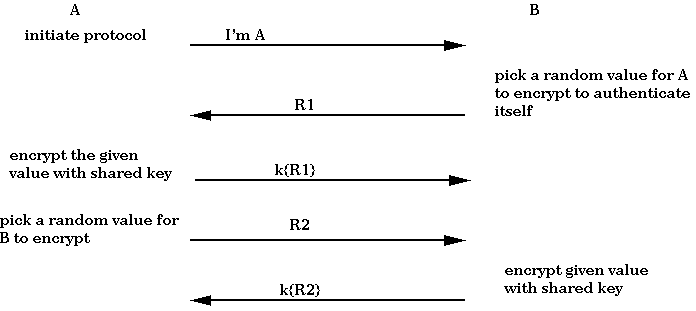Symmetric Cryptosystems and Authentication
Lecturer: Professor Fred B. Schneider
Lecture notes by
Lynette I. Millett
Last time we discussed several primitive cryptosystems. We mentioned two
properties, confusion and diffusion, that are desirable in any
cryptosystem.
There are three
classes of cryptographic functions that turn out to be useful:
- secret key -- one key, referred to as the secret key; we saw examples
of this last time,
- public key -- two keys, referred to as private and public keys,
- hash -- zero keys.
Secret Key Cryptography
Secret key cryptography involves two functions:
- encryption: E(key, message) -> enciphered text
- decryption: D(key, ciphertext) -> message.
These functions are inverses of each other, so that message
= D(key, E(key, message)). The E and D notation is a bit verbose, so we
will use the notation k{m} to say that
message m was encrypted under key k.
Uses for secret key cryptography include: transmitting secret
messages in the presence of passive eavesdroppers, storing information
in encrypted form on insecure media, and authentication (determining
who is involved in a given dialogue.) Note: if you are using
encryption to store data on insecure media, most editors work on a
decrypted form of data. Thus, they may store temporary unencrypted
versions of your data.
Authentication, as we have seen it before, is often done with a
password. However, that form of authentication involves revealing the
'secret' (password) in order to prove one's identity. We are
interested in strong authentication--providing proof of
identity without revealing the secret. In other words, strong
authentication involves proving knowledge of a secret (key/password)
without revealing the secret itself.
Suppose we would like user A to prove to user B that A is A
without revealing the secret that is the essence of being A, and vice
versa. Thus, we desire a protocol that allows A and B to authenticate
themselves to each other. Assume that there is a shared, secret key:
k. Knowing k is proof of being either A or B. The desired mutual
authentication protocol works as outlined below. The arrows indicate
sending a message.
 There are many subtle errors that can arise when designing
cryptographic protocols. We now illustrate some. First, note in the
above protocol that B sends A two messages in a row. An obvious
optimization might be to combine those messages into one, as well as
having A announce itself and send a random bit string for B to encrypt
at the same time.
There are many subtle errors that can arise when designing
cryptographic protocols. We now illustrate some. First, note in the
above protocol that B sends A two messages in a row. An obvious
optimization might be to combine those messages into one, as well as
having A announce itself and send a random bit string for B to encrypt
at the same time.
 This protocol, however, if flawed. In particular, it is susceptible to
what is known as a reflection attack. It is possible for an
eavesdropper, T, to convince B that T is A. T exploits the fact that B
seems willing to encrypt challenges. Therefore, T can pretend to be A
as follows:
This protocol, however, if flawed. In particular, it is susceptible to
what is known as a reflection attack. It is possible for an
eavesdropper, T, to convince B that T is A. T exploits the fact that B
seems willing to encrypt challenges. Therefore, T can pretend to be A
as follows:
 After B sends R1 to T, T needs to get it encrypted under k in order
to convince B that T is A. T therefore starts another session, sending
R1 which B then returns encrypted. T now learns the encrypted
version of R1 and can convince B that B is communicating with A.
After B sends R1 to T, T needs to get it encrypted under k in order
to convince B that T is A. T therefore starts another session, sending
R1 which B then returns encrypted. T now learns the encrypted
version of R1 and can convince B that B is communicating with A.
There are several possible approaches to repairing the protocol:
- Use two different keys, one from A to B and another from B to A. This
introduces additional keys to keep track of.
- Insist that the challenge from the initiator look different from the
challenge from the responder. If this holds, then T can never get B to
encrypt the 'right thing.' For instance, suppose A generates random even
numbers and B generates random odd numbers. Then B would never encrypt a
random number that it had generated (as in the above example.)
- Initiator must prove its identity first. This is based on the assumption
that the initiator in a protocol is likely to be the attacker (if anyone
is). In the above examples, B would respond with a challenge of its own
before responding to A's (T's) challenge. The reflection attack in this
type of protocol would not work.



